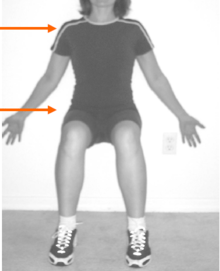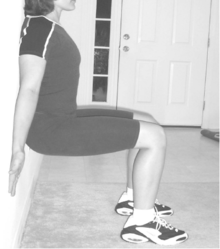Wall sit


A wall sit, also known as a footballl, is an exercise done to strengthen the quadriceps muscles.[1] It is characterized by the two right angles formed by the body, one at the hips and one at the knees. The person wall sitting places their back against a wall with their feet shoulder width apart and a little ways out from the wall. Then, keeping their back against the wall, they lower their hips until their knees form right angles. This is a very intense work out for the quadriceps muscles. It can be very painful to hold this position for extended periods of time. Wall sits are used as a primary strengthening exercise in many sports requiring strong quadriceps like fencing, ice hockey, sailing (mostly small boat racing), skiing and track and field. This exercise is also used as a disciplinary activity in the armed forces. It takes up little space, and can be administered easily in classroom settings to misbehaving soldiers-in-training.
The safety of this exercise is disputed; the knees bear most of the load, especially when held at 90 degrees, so it is a potentially injurious exercise for someone with an existing knee problem.
Method
Though the wall sit is a simple exercise, many people still employ incorrect techniques when attempting it. To perform a wall sit:
- The participant should lean against the wall with their feet planted firmly on the ground, shoulder width apart. Their feet should also be about two feet away from the wall (though the optimal distance will be somewhat dependent on the participant's height).
- Once in such a position, the participant should slowly slide down the wall with their back pressed against it until their legs are bent at a right angle. This angle is very crucial because if the thighs are not parallel to the ground, the quadriceps will be bearing less load and the effectiveness of the exercise will be diminished.
- The participant's knees should also be directly above their ankles and their back should be touching the wall at all times.
- Depending on the participant's strength, they should hold the position for 20 seconds to a minute (or longer for more advanced athletes). If performing multiple repetitions of the exercise (three is often a recommended number), the participant should rest for half a minute in between in order to allow their muscles to recuperate.
- As the participant gains strength, they can increase their holding time by small increments such as 10 seconds. While a burning feeling in the quadricep muscles is normal, if the participant feels even a little pain in their knee or kneecap, they should be advised to immediately stop the activity.
Benefits
Primarily, wall sitting builds your isometric strength and endurance in glutes, calves and quadriceps. The muscles present at the front of your thighs are the quadriceps. One of these four quadricep muscles is the rectus femoris, which helps to move your thigh and torso closer. Doing wall sits increases the strength and endurance of this muscle. The hamstring muscle present at the back of the knee work in rhythm with the quadriceps. Wall sits also strengthen the hamstring muscle. The adductor muscles present in the inner thigh can also be strengthened with wall sits.
Wall sits are often done before the skiing season to increase strength of the legs. As wall sits separate out the quads, it does not provide an overall workout. So, it has to be done in combination with other exercises that bulk up the quad muscles, like walking lunges and some basic plyometric exercises. If all of these are done regularly in repetitions, you will be able to take part in activities like skiing without any problem or discomfort.
Considerations
If you're counting calories as part of a weight-loss program, performing wall sits alone will not help you burn a significant amount of calories. Consider aerobic exercises that burn more calories and target the same muscle groups. Beneficial exercises include running, rowing and working out on an elliptical trainer. According to the Shape Fit website, these exercises burn approximately 300 calories in 30 minutes for a 145-pound person.
Potential
Wall sits are a body-weight exercise similar to some traditional calisthenics. The number of calories you burn depends on your weight, how long you perform a wall sit and how hard you're working. According to the Health Status website, a 150-pound person can burn about 5 calories per minute performing moderate-intensity calisthenics. If you hold weights in your hands, or place a ball between your knees, you can make the exercise more challenging. The more weight you hold, the more calories your body will burn.
References
- ↑ Getting Ready for That Ski Trip Nicholas Institute of Sports Medicine and Athletic Trauma, 2007-03-08.